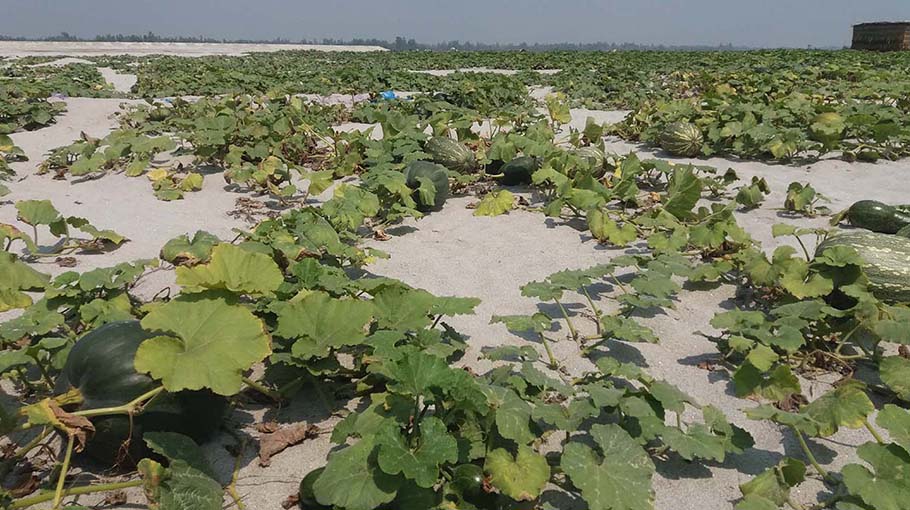Sweet pumpkin farming brings cheers for Teesta char farmers

Something is better than nothing- believing this concept many farmers have turned their luck by cultivating sweet pumpkins on char. On the basis of research, work was started keeping in view the development of agricultural production and quality of life of landless farmers. And in the first year, success has achieved in cultivating sweet pumpkin in Peat method on uncultivated and fallow char land. From there the story is moved forward.
The number of farmers has increased from hundreds to thousands now. Affluence has returned to the family of these landless farmers by producing sweet pumpkin.
With the initiative and support of Practical Action, a non-governmental development organization, the success of sweet pumpkin cultivation on the char island is now being seen all over the country.
The success of this technology of cultivating sweet pumpkins on the once fallen shelf is now evident in the socio-economic development of the impoverished people affected by river erosion in the country.
In 30 to 40 river erosion areas of the country including Teesta, millions of families have lost everything and live on the flood defenses.
If this huge population can be brought under this technology, then there will be a revolution in various issues related to agricultural production.
The Department of Agricultural Extension and Practical Action for Poverty Alleviation through Invented Agricultural Technology has cultivated sweet pumpkin on about 150 hectares of land in four unions of Gangachara Upazila and about 70 hectares of Kaunia Upazila this year. The pumpkins produced are currently being exported to different districts including Dhaka.
Gangachara Upazila Agriculture Officer Shariful Islam said farmers are becoming interested in cultivating pumpkins this season on the Teesta shelf with low yields and low prices.
AZM Nazmul Islam Chowdhury, Head of Extreme Poverty Program, Practical Action, Bangladesh, said that from 2005 to 2009, 3,273 farmers in the char region produced 33,000 metric tons of pumpkins on 1,250 hectares of land. Its local market value is 22 crore.
To sustain this success, in 2009 the government and DFID assisted in the expansion of sweet pumpkin cultivation through the EEPC Project in five districts in the North West. Highlighting the success of this initiative of Practical Action, Bangladesh from 2009 to 2014, he said that 19,025 hectares of shelf were brought under cultivation through 'Pathways from Poverty’ project.
In those years, 12,857 landless poor farmers produced about 50,000 metric tons of sweet pumpkins. Its market value is 39 crore 32 lakh Tk.
Nazmul Islam said, “This technology of sweet pumpkin production has appears to the landless as a beacon of hope.
Not only the farmers of the project, but also the farmers outside it are benefiting by following and adopting this technology as well as getting success. Mentioning that the landless are getting a fair price for their hard-earned crops, he said that there is a big problem in getting a fair price for the produce of grassroots farmers in the country's market.
That is why we are connecting them with different markets at home and abroad.
At present this sweet pumpkin is being exported to several countries.”




